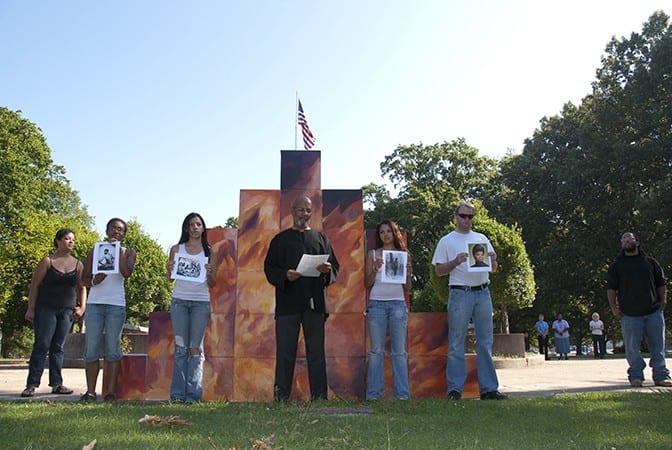
In 2009, performance art blocked the view of the statue of the Klan’s first grand wizard and slave trader
The time that guerilla art made Nathan Bedford Forrest’s statue disappear
by Wendi C. Thomas | August 14, 2017 1:00 pm
This article first appeared on MLK50: Justice Through Journalism.
In a controversial public space that houses the remains of a long-dead Confederate war veteran and sparks strong sentiments among the living, stories that are usually muffled can be heard.
Saturday morning, a group of students and volunteers proved that to be true with an hourlong performance art piece directly in front of the Nathan Bedford Forrest monument in the Downtown park named for the Ku Klux Klan leader.
University of Memphis’ Richard Lou, the first nonwhite chairman of the art department, sought no permission for this performance, as the “guerrilla” nature of the piece was part of the point.
Worries that the police would usher everyone out were unfounded, as the park officers who drove up on the grounds seemed fascinated by the piece; one officer took pictures with a cell phone camera.
Cubes, when arranged in a pyramid formed an 8-foot-high image of fire. They were carefully taken down by university volunteers, and re-stacked again and again — into a map of the Mississippi River, a Choctaw warrior, a drawing of a slave auction, of Fort Pickering and lastly, what the park would look like if, magically, Forrest disappeared.
During the construction, two students sang spirituals. When each image was whole, a Memphian would stand in front of the pyramid and tell a story.
Robert Bain spoke of completing the park with a monument to anti-lynching activist and Memphis journalist Ida B. Wells.
Elaine Blanchard, a Unitarian minister, told a childhood story of an elderly neighbor who cut through a wire fence to make a gate for her, a single act of kindness and acceptance never forgotten.
Lou’s son, Ming, 16, spoke of his grandfather, a Chinese immigrant who worked in the Mississippi Delta.
Immigration activist Francisco Dias spoke of police tearing up his car in search of drugs that weren’t there, treatment he suspects was based on his Latino heritage and souped-up ride.
Art professor Earnestine Jenkins told of her grandfather, Garvin Fouse, who fought in World War I, in a rare black fighting division.
And Augustin Diaz, danced in full Aztec warrior garb, as Raul Venegas drummed for a crowd of about 50.
Sitting in the grass was art buff and local basketball legend Elliot Perry. “Whether it’s a monument of pride or humiliation, it just depends on who’s looking at it,” he said.
“Life is learned through art. I’m looking through different goggles, but I don’t see it as a rich and noble heritage.”
Lou, of Mexican and Chinese descent, was more direct: The fact that the monument exists is a testament to white supremacy; his piece adds historical accuracy.
The assembling and dissembling of the cubes was designed to repudiate and complicate the space and the story, and do what good art does — spark dialogue.
Who is allowed to tell what stories in contested public spaces?
Whose stories do we honor?
Whose stories are left out?
It’s not about redacting history, as critics might accuse, but fleshing it out and moving away, Lou said, from the binary construction of race and including the stories of the growing Latino community, stories that will become Memphis’ heritage.
Framing and reframing the monument each time the cubes shifted to form new images, the movement brought the rapt crowd into the present with stories of times gone by.
And in a space that has been home to just one story — Forrest’s — it was fitting that on this day, he had no one there to speak for him.
He sat there mute, trapped as if in prison, as the future danced all around him.
